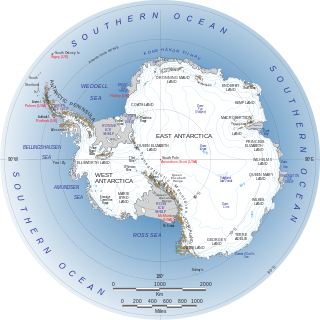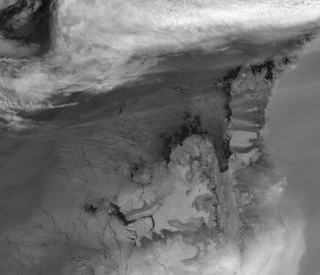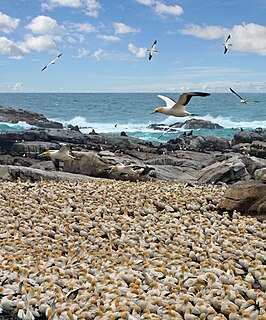Scullin Monolith is a crescent-shaped rock fronting the sea 6 km (3.7 mi) west of the similar Murray Monolith, and 8 km (5.0 mi) from Torlyn Mountain, in Mac. Robertson Land, Antarctica. Early in January 1930 the British Australian New Zealand Antarctic Research Expedition (BANZARE) under Douglas Mawson made an aerial flight from the ship over the area. Mawson set foot on the rock on 13 February 1931 and named it for James Scullin, Prime Minister of Australia in 1929 - 31. The rock was charted in January and February 1931 from Norwegian whale catchers exploring the coast, and named "Mount Klarius Mikkelsen" for Captain Klarius Mikkelsen, master of the whale catcher Torlyn. Mikkelsen Peak is retained as the name of the highest peak of the outcrop.

East Antarctica, also called Greater Antarctica, constitutes the majority (two-thirds) of the Antarctic continent, lying on the Indian Ocean side of the continent, separated from West Antarctica by the Transantarctic Mountains. It lies almost entirely within the Eastern Hemisphere and its name has been accepted for more than a century. It is generally higher than West Antarctica and includes the Gamburtsev Mountain Range in the centre.

The Windmill Islands are an Antarctic group of rocky islands and rocks about 11.1 kilometres (6 nmi) wide, paralleling the coast of Wilkes Land for 31.5 kilometres (17 nmi) immediately north of Vanderford Glacier along the east side of Vincennes Bay. Kirkby Shoal is a small shoal area with depths of less than 18 metres (59 ft) extending about 140 metres (459 ft) westwards and SSW, about 3.4 kilometres (2.1 mi) from the summit of Shirley Island, Windmill Islands, and 0.24 kilometres (0.15 mi) NW of Stonehocker Point, Clark Peninsula.

Ardery Island is a steep, rocky island, about 1 km (0.62 mi) long, lying 1.8 km (1.1 mi) west of Odbert Island in the Windmill Islands of Antarctica.

Herring Island is an Antarctic rocky island, 3.7 km (2 nmi) long, lying 1.9 km (1 nmi) east of Cloyd Island in the south part of the Windmill Islands. It was first mapped from air photos taken by USN Operation Highjump and Operation Windmill in 1947 and 1948. Named by the US-ACAN for Lt. Charles C. Herring, USN, photographic officer with Operation Windmill parties which obtained air and ground photos of the area in January 1948.

Odbert Island is a rocky island, 2.4 km (1.5 mi) long, between Ardery Island and Robinson Ridge in the Windmill Islands of Antarctica.
Murray Monolith is a detached part of Torlyn Mountain in Mac.Robertson Land, Antarctica. It was discovered during the British Australian New Zealand Antarctic Research Expedition (BANZARE), led by Mawson, 1929–1931, and named after Sir George Murray, Chancellor of the University of Adelaide and a patron of the expedition.
Clark Peninsula is a rocky peninsula, about 3 km (2 mi) long and wide, lying 5 km north-east of Australia's Casey Station at the north side of Newcomb Bay on the Budd Coast of Wilkes Land in Antarctica.

The Rookery Islands are a group of rocks and small islands in western Holme Bay, north of the David and Masson Ranges in Mac.Robertson Land in East Antarctica. The group contains breeding colonies of Adélie penguins, Cape petrels, snow petrels, southern giant petrels, Wilson's storm petrels and Antarctic skuas. The islands are protected under the Antarctic Treaty System as Antarctic Specially Protected Area (ASPA) No.102.

Nelly Island is the largest and easternmost of the Frazier Islands, lying in Vincennes Bay off Wilkes Land, East Antarctica.

Dewart Island is the central island in the Frazier Islands, in Vincennes Bay, Wilkes Land, East Antarctica.
Moutonnée Lake is a sub-glacial lake that lies within Moutonnee Valley, marginal to the George VI Ice Shelf, 7 km (4.3 mi) south of Ablation Point indenting the east coast of Alexander Island, facing the west coast of Palmer Land, Antarctica. Following limnological and tidal studies by the British Antarctic Survey (BAS) from 1971, it was named by the United Kingdom Antarctic Place-Names Committee (UK-APC) from the presence of roche moutonnées on its shores. As with nearby Ablation and Hodgson Lakes, Moutonnée receives large masses of ice from the adjacent George VI Ice Shelf in George VI Sound, making life in the lake unsustainable. The site lies within Antarctic Specially Protected Area (ASPA) No.147.

Haswell Island is the largest of the Haswell Islands, lying off the coast of Antarctica, about 3 kilometres (1.5 nmi) north of Mabus Point in Queen Mary Land. It was discovered by the Western Base Party of the Australasian Antarctic Expedition, 1911–14, under Mawson, and named by him for Professor William A. Haswell, a zoologist at Sydney University and a member of the expedition's Advisory Committee.

Hawker Island is an irregularly shaped island about 2 km (1.2 mi) long, lying some 7 km south-west of Davis Station between Mule Island and Mule Peninsula, Vestfold Hills, in the eastern part of Prydz Bay, Antarctica. It was mapped by Norwegian cartographers from aerial photographs taken by the Lars Christensen Expedition, 1936–37. It was remapped by the Australian National Antarctic Research Expeditions (1957–58) and named after Alan Charles Hawker, a radio supervisor at Davis Station in 1957.

The Marion Nunataks are a small group of nunataks rising to about 600 m (2,000 ft) on Charcot Island, in the eastern Bellinghausen Sea of Antarctica. They form a 12 km chain of rocky outcrops on the mid-north coast of the island, stretching from Mount Monique at the western end to Mount Martine in the east.

Lamarck Island is a rocky island 250 m (820 ft) long, lying 300 m (980 ft) east of Petrel Island and 300 m (980 ft) north-east of Rostand Island in the Géologie Archipelago, off the Adélie Coast of Antarctica. It was charted in 1951 by the French Antarctic Expedition and named by them after Jean-Baptiste Lamarck, the French naturalist.

Amanda Bay, also sometimes known as Hovde Cove, lies in southern Prydz Bay on the Ingrid Christensen Coast of Princess Elizabeth Land, East Antarctica. It is best known for its breeding colony of several thousand pairs of emperor penguins on sea ice at the south-west corner of the bay.
Bailey Peninsula is a rocky peninsula, about 2.6 km (2 mi) long and 1.5 km (1 mi) wide, on the Budd Coast of Wilkes Land in Antarctica. It is the site of Australia’s Casey Station.














